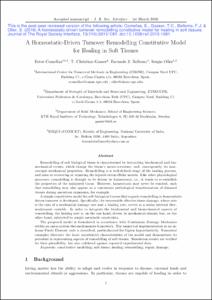Mostra el registre d'ítem simple
A homeostatic-driven turnover remodelling constitutive model for healing in soft tissues
| dc.contributor.author | Comellas Sanfeliu, Ester |
| dc.contributor.author | Gasser, Thomas Christian |
| dc.contributor.author | Bellomo, Facundo J. |
| dc.contributor.author | Oller Martínez, Sergio Horacio |
| dc.contributor.other | Universitat Politècnica de Catalunya. Departament de Física |
| dc.contributor.other | Universitat Politècnica de Catalunya. Departament d'Enginyeria Civil i Ambiental |
| dc.date.accessioned | 2016-03-29T19:19:45Z |
| dc.date.available | 2017-04-01T00:31:00Z |
| dc.date.issued | 2016-03 |
| dc.identifier.citation | Comellas, E., Gasser, T., Bellomo, F., Oller, S. A homeostatic-driven turnover remodelling constitutive model for healing in soft tissues. "Journal of the Royal Society Interface", Març 2016, vol. 13, núm. 116, 14 p. |
| dc.identifier.issn | 1742-5689 |
| dc.identifier.uri | http://hdl.handle.net/2117/84831 |
| dc.description.abstract | Remodelling of soft biological tissue is characterized by interacting biochemical and biomechanical events, which change the tissue's microstructure, and, consequently, its macroscopic mechanical properties. Remodelling is a well-defined stage of the healing process, and aims at recovering or repairing the injured extracellular matrix. Like other physiological processes, remodelling is thought to be driven by homeostasis, i.e. it tends to re-establish the properties of the uninjured tissue. However, homeostasis may never be reached, such that remodelling may also appear as a continuous pathological transformation of diseased tissues during aneurysm expansion, for example. A simple constitutive model for soft biological tissues that regards remodelling as homeostatic-driven turnover is developed. Specifically, the recoverable effective tissue damage, whose rate is the sum of a mechanical damage rate and a healing rate, serves as a scalar internal thermodynamic variable. In order to integrate the biochemical and biomechanical aspects of remodelling, the healing rate is, on the one hand, driven by mechanical stimuli, but, on the other hand, subjected to simple metabolic constraints. The proposed model is formulated in accordance with continuum damage mechanics within an open-system thermodynamics framework. The numerical implementation in an in-house finite-element code is described, particularized for Ogden hyperelasticity. Numerical examples illustrate the basic constitutive characteristics of the model and demonstrate its potential in representing aspects of remodelling of soft tissues. Simulation results are verified for their plausibility, but also validated against reported experimental data. |
| dc.format.extent | 14 p. |
| dc.language.iso | eng |
| dc.subject | Àrees temàtiques de la UPC::Ciències de la salut::Medicina::Anatomia i fisiologia humana |
| dc.subject | Àrees temàtiques de la UPC::Matemàtiques i estadística::Anàlisi numèrica::Mètodes en elements finits |
| dc.subject.lcsh | Homeostasis--Mathematical models |
| dc.subject.other | constitutive modelling |
| dc.subject.other | soft tissue |
| dc.subject.other | healing |
| dc.subject.other | remodelling |
| dc.subject.other | repair |
| dc.subject.other | damage |
| dc.subject.other | COMP-DES-MAT Project |
| dc.subject.other | COMPDESMAT Project |
| dc.subject.other | COMP-DES-MAT Project |
| dc.subject.other | COMPDESMAT Project |
| dc.title | A homeostatic-driven turnover remodelling constitutive model for healing in soft tissues |
| dc.type | Article |
| dc.subject.lemac | Homeòstasi |
| dc.contributor.group | Universitat Politècnica de Catalunya. RMEE - Grup de Resistència de Materials i Estructures en l'Enginyeria |
| dc.identifier.doi | 10.1098/rsif.2015.1081 |
| dc.description.peerreviewed | Peer Reviewed |
| dc.relation.publisherversion | http://rsif.royalsocietypublishing.org/content/13/116/20151081 |
| dc.rights.access | Open Access |
| local.identifier.drac | 17676837 |
| dc.description.version | Postprint (author's final draft) |
| dc.relation.projectid | info:eu-repo/grantAgreement/EC/FP7/320815/EU/Advanced tools for computational design of engineering materials/COMP-DES-MAT |
| local.citation.author | Comellas, E.; Gasser, T.; Bellomo, F.; Oller, S. |
| local.citation.publicationName | Journal of the Royal Society Interface |
| local.citation.volume | 13 |
| local.citation.number | 116 |
Fitxers d'aquest items
Aquest ítem apareix a les col·leccions següents
-
Articles de revista [2.208]
-
Articles de revista [3.017]
-
Articles de revista [125]


